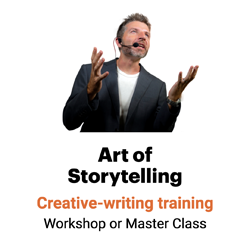Go beyond the interview
My writing team had one of those tough assignments recently that only a geek like me can fully appreciate.

Our job: to transform technical medical text into a fascinating research report that patients, donors and neurointerventionalists alike can understand and enjoy. In some sections, superstar writer Dawn Grubb literally had to look up and define a term in every sentence.
But definitions and descriptions take you only so far. Sometimes it takes an analogy to fully explain technical topics to readers. So I was delighted to read this passage by Dawn:
Google Earth allows users to zoom in on its satellite images to see the smallest detail — from continent, to country, to state, to city, to street, to building. With functional mapping, our doctors can view the whole brain’s structure and activity the same way — down to its regions, functional lobes, neuron bundles, individual neurons, and neuron particles.
Writing complex copy? Add an analogy.
Here’s how:
1. Ask your subject-mattter expert.
Sometimes, all you need to do to get a comparison is to ask. The question to ask to get a metaphor is “What’s it like?”
That’s the approach Roger von Oech, author of A Whack on the Side of the Head, recommends. His workshop participants ask:
“What’s it like?” to create metaphors for the meaning of life. Two of my favorites:
Life is like an unassembled abacus. It’s what you make of it that counts.
Life is like a maze in which you try to avoid the exit.
To help your subject-matter expert provide an analogy that anyone can understand, ask the question:
If you were explaining this concept to a class of third graders, what would you say it was like?
2. Ask Google a question.
But what do you do when it’s just you and a ream of technical documents with no human expert in sight? That’s when Dawn and I turn to our best friend and research assistant, Google, for help.
Dawn started her search on neurointerventionalists by typing “What is brain mapping?” into the Google search box. The results took her to an almost poetic answer at How Stuff Works, one of my favorite Websites for defining, describing and comparing technical terms.
At How Stuff Works, you can learn enough about complicated processes and procedures — from LASIK surgery to liposuction, from cloning to currency — to be able to describe them in conversational terms. And, if you’re as lucky as Dawn was, you might find a good analogy there, as well.
3. Turn Google into a thesaurus.
Just type “define: term” into Google’s search box. You’ll get all the definitions of your terms that appear on the Web — and you just might get a free, bonus analogy.
For a blog post, I recently Googled “define: cochlear implant.” One result included this analogy:
The cochlear implant is often referred to as a bionic ear.
My lead for the blog post:
Think of a cochlear implant as a bionic ear.
4. Get a quick education online.
Once you’ve chosen your analogy, you need to develop it.
When I was developing a horse-racing analogy for a behavioral finance article in a mutual fund company’s marketing magazine, I needed a lot of help.
I turned to OneLook Reverse Dictionary and looked up horse-racing to brush up on the vocabulary. This tool lets you describe a concept to get a list of words and phrases related to that concept.
Then I looked at Wikipedia’s horse-racing page for a fast education on the topic.
Between these two resources, I found enough anecdotes and analogies, facts and phrases and images and ideas to develop extended analogies for several articles. Here’s one section of the final piece:
Don’t lose by a head.
In the 1957 Kentucky Derby, jockey Bill Shoemaker misjudged the finish line and stopped riding Gallant Man for just a moment. That move gave Iron Liege and Bill Bartack the victory.
There are a lot of inches in a 1 3/16-mile race, and Gallant Man lost by just a few of them.
There are a lot of decisions in a lifetime of investing, and your portfolio can get beaten by a few bad ones. Here are four common emotional investing missteps to avoid …
Find and develop your analogy.
Don’t have access to a subject-matter expert? That’s no reason not to add an analogy to make your technical topic easier to understand. Instead, use Google and other online tools to identify and develop analogies for your complex concept.

Leave a Reply